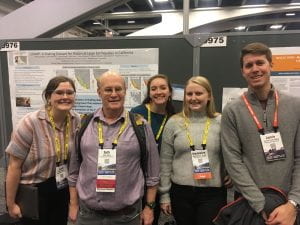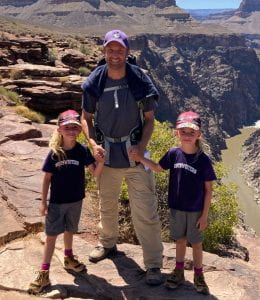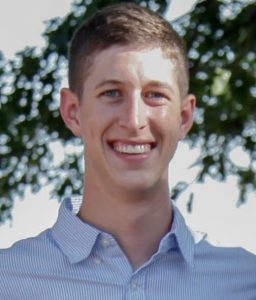For an overview of our group’s recent research, click here
California Historical Intensity Mapping Project (CHIMP) presentation at the 2019 AGU national meeting, for which Molly Gallahue (center) received an Outstanding Student paper award.
For a CHIMP project overview, click here or here
Recent Ph.D. students:
Earthquake clustering and hazards
I study large earthquake temporal clusters from a probabilistic perspective. This includes simulating paleo-earthquake records that exhibit temporal clusters to understand the broad characteristics and behavior of faults in different tectonic regimes. My research proposes an alternative to the traditional earthquake cycle model that allows a fault’s past to influence its future likelihood of experiencing an earthquake. Additionally, my research looks at qualitative intensity distributions from large historical earthquakes in California, which can facilitate a better understanding of how well current probabilistic seismic hazard assessments reflect the observed record of earthquake intensities and damage.
2017 Seismological Society of America Student Presentation Award
2019 American Geophysical Union Centennial Grant Recipient
Student Representative, Natural Hazards Section, American Geophysical Union
2021 AGU Natural Hazards Section Award for Graduate Research
SSA blog: Seismologists At Work: Leah Salditch
Northwestern News: students gather earthquake memories
Graduate School Spotlight: Leah Salditch
Awarded department`s Horace Scott Award for Outstanding Graduate Research and Potential
Now Assistant Vice President, Geoscience Peril Advisor, Guy Carpenter
Midcontinent Rift and Plate Motions
I’m interested broadly in plate tectonics and structural geology, and my research involves studying North America’s Midcontinent Rift (MCR) and how it can provide insight into the continental rifting process in general. It appears that the MCR contains many features found in other rifts as well as passive continental margins, and studying their structure as well as geophysical properties such as gravity and magnetics sheds light on their possible evolutionary paths. I’ve also been involved in working on paleo-plate tectonic reconstructions and paleomagnetics of the Precambrian, and plan to further study apparent polar wander and how changes in direction might be linked to tectonic activity such as rifting.
Student Representative, Geophysics and Geodynamics Division, Geological Society of America
Now visiting assistant professor, Grand Valley State University
Earthquakes and seismic hazards
My research focuses on earthquakes, including both seismic hazards and what they tell us about long-term geologic processes. My previous research has included seismicity studies of lithosphere tearing and subsequent transform fault development along the Australia-Pacific subduction zone. Using Coulomb Failure Stress, b-value, and earthquake rupture property analyses, I examined the transform plate boundary development process. I have studied the seismic hazards posed by earthquakes along the eastern continental margin of North America and by normal fault earthquakes worldwide by examining what the possible maximum earthquake magnitude might be. I have also assessed the uncertainty of earthquake stress drop measurements. Currently, I am developing methods to improve earthquake recurrence time estimates using the Long-Term Fault Memory model.
2020 Seismological Society of America Student Presentation Award
2019 Seismological Society of America Student Presentation Award
Student Representative, Societal Impacts and Policy Sciences Section, American Geophysical Union
Now NSF Postdoctoral Fellow, University of Chicago
Molly Gallahue
Earthquake hazards and continental rifting
I’m working on comparing results of the California Historical Intensity Mapping Project (CHIMP), which involved reinterpreting previously published felt intensities from large earthquakes in California to create a database of past shaking levels, to earthquake hazard maps. I’m also studying processes involved in continental rifting. Specifically, I am looking at volumes of magmatic material produced at volcanic rifted margins in comparison to distances from hotspots or pole of plate rotation. Ideally this will allow us to try to better understand how continents rift and why some rifts ultimately fail to evolve to full spreading centers, as happened with North America’s Midcontinent Rift.
2019 American Geophysical Union Outstanding Student Presentation Award (video)
2019 American Geophysical Union Centennial Grant Recipient
Student Representative, Geophysics and Geodynamics Division, Geological Society of America
Northwestern News: students gather earthquake memories
Awarded department`s Marion Sloss Award for Outstanding Graduate Teaching Assistant
2022 Geological Society of America Outstanding Student Presentation Award
2023 AGU Natural Hazards Section Award for Graduate Research
Seismological Society of America blog post: Bon Voyage
Now Senior Catastrophe Model Developer, Gallagher Re

Earthquake sources
My research involves the mathematical description of seismic sources and the uncertainties related to their determination. Moment tensors can be decomposed into components representing geologic processes. The most common decomposition of moment tensors is into an isotropic component, a double-couple component (DC) and a non-double couple component (NDC). While the DC component describes slip on a fault, NDC components may be required to describe complex source processes, but their appearance during the inversion has also been attributed to noise in the data, insufficient station coverage, and uncertainties in the structure of the Earth or the location of the earthquake. I am investigating whether non-double couple components in seismic moment tensors represent real source processes.
Awarded department`s Horace Scott Award for Outstanding Graduate Research and Potential and Marion Sloss Award for Outstanding Graduate Teaching Assistant
Now Assistant Professor at the Center for Scientific Research and Higher Education (CICESE) in Ensenada, Mexico.
I have had the good fortune to work with many other outstanding students. I have been a thesis advisor to:
Douglas Wiens; (Ph.D. 1985), now Brookings Distinguished Professor, Washington University in St. Louis; Fellow, American Geophysical Union
Joe Engeln; (Ph.D. 1985), now retired Assistant Director for Science, Missouri Department of Natural Resources
Paul Stoddard; (Ph.D. 1989), now Associate Professor, Northern Illinois University
Gary Acton*; (Ph.D. 1990), now Manager of Technical & Analytical Services, International Ocean Discovery Program, Texas A&M University; Fellow, Geological Society of America
George Helffrich; (Ph.D. 1990), now Professor emeritus, Tokyo Institute of Technology Earth-Life Science Institute; Fellow, American Geophysical Union
Tom Shoberg+; (Ph.D. 1993), now Research Geophysicist, U.S. Geological Survey
John Weber*+; (Ph.D. 1995), now Professor, Grand Valley State University (Michigan); Fellow, Geological Society of America
John Delaughter+; (Ph.D. 1998), now geophysicist, Devon Oil
Lisa Leffler+*, (Ph.D. 1999), now Earth Science teacher, Fairhope Alabama
Andy Newman+; (Ph.D. 2000), now Professor, Georgia Institute of Technology
Fred Marton; (Ph.D. 2001), now Associate Professor, Bergen Community College (New Jersey)
Eryn Klosko; (Ph.D. 2002), now Department Chair and Professor, Westchester Community College (New York)
Alberto Lopez; (Ph.D. 2006), now Associate Professor, University of Puerto Rico
Kimberly Schramm; (Ph.D. 2007), now seismologist, Sandia National Laboratory
Carl Ebeling+; (Ph.D. 2012), now Senior Development Engineer, UC San Diego
Laura Swafford+; (Ph.D. 2013), now geophysicist, Chevron
Miguel Merino+; (Ph.D. 2014), now geophysicist, Chevron
Edward Brooks+; (Ph.D. 2019), now Natural catastrophe specialist, Swiss Re
I have also worked with:
Paul Lundgren; (Ph.D. 1988), now Principal research scientist and group supervisor, Jet Propulsion Laboratory, California Institute of Technology
Charles DeMets*; (Ph.D. 1988), now Wegener Professor of Geophysics, University of Wisconsin-Madison; Fellow, American Geophysical Union
Don Argus; (Ph.D. 1990), now Principal Scientist, Jet Propulsion Laboratory, California Institute of Technology; Fellow, Geological Society of America and Fellow, American Geophysical Union
John Brodholt; (Ph.D. 1992), now Professor, University College, London
Phil Richardson+; (Ph.D. 1998), now Intellectual Property Manager, Earth Science & Technical Computing, Chevron
Emily Wolin; (Ph.D. 2015), now Research Geophysicist, U.S. Geological Survey
*Students whose joint paper with me won an AGU Outstanding Student Paper Award
+Awarded the department`s Horace Scott Award for Outstanding Graduate Research and Potential






